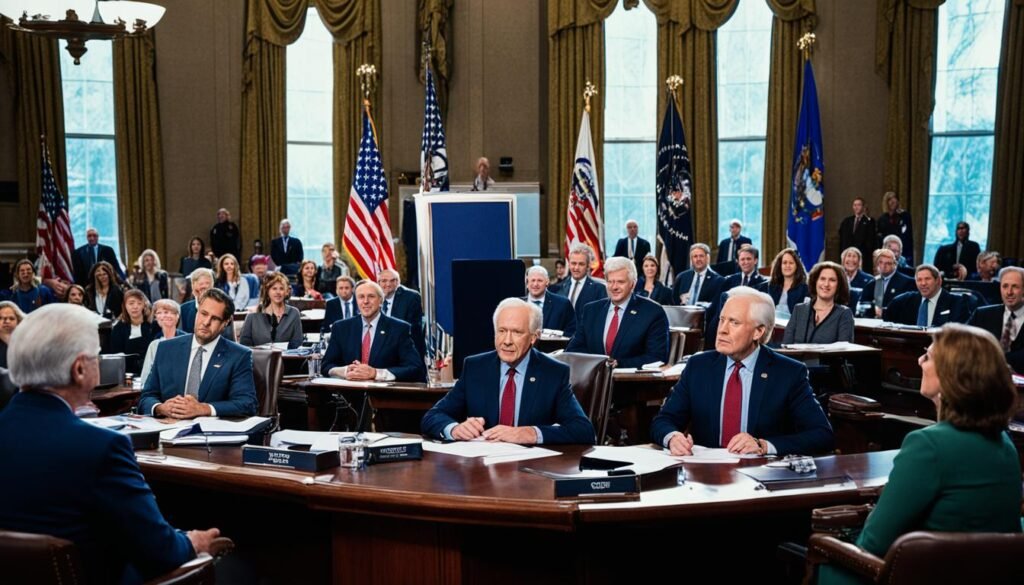Legislation shapes our laws, covering issues from taxes to personal rights. The legislative process is long, beginning with an idea then becoming law. We will look at how laws go from a simple thought to real action. Knowing this journey helps us all take part in making laws that matter.
Also Read: The Evolution Of The Legal Profession: A History Of Lawyer
Key Takeaways
- Legislation is the foundation of our legal system, governing all aspects of society.
- The legislative process is a complex journey that starts with an idea and ends with a signed law.
- Understanding the legislative process is crucial for citizens to engage with their government and influence laws.
- The legislative process involves multiple stages, including proposal, committee consideration, floor debate, and final approval.
- The U.S. Congress, consisting of the Senate and the House of Representatives, plays a central role in the legislative process.
Introduction
The legislative process is key in our democracy. It lets people help make laws they follow. Knowing how laws are made in the US helps us work with elected leaders. This way, we can change laws that matter to us. The journey of a law, from first idea to final approval, is what we’ll cover.
Also Read: Roles And Responsibilities Of An Attorney In Modern Legal Systems
The Importance of Understanding the Legislative Process
Understanding the legislative process is vital for active citizenship. By knowing how a bill becomes a law, citizens can stand up for what they believe in. They can talk to their leaders and help shape their community’s laws. This knowledge gives power to everyone to be active in government.
Overview of the Legislative Journey
Changing an idea into a law is complex yet vital. It all starts with a bill and includes many steps like committee checks and debates. People at all levels talk, work, and revise the bill. Finally, the President signs it into law. This shows the how laws are made in US steps in action.
The U.S. Congress

The United States Congress is where the country’s laws are made. It has two parts, the Senate and the House of Representatives. Both work together to create, discuss, and pass laws for the country. This makes Congress very important in America’s governing process.
Also Read: Inside The Courtroom: An In-depth Look At Judicial Proceedings
The Senate and House of Representatives work closely but have different jobs. The Senate is like the big brother. It has 100 members, two from each state. They serve for six years. In the Senate, important things like agreeing to treaties, confirming key government positions, and overseeing impeachment trials happen.
The House of Representatives
The House of Representatives is like the younger sibling. It has 435 members based on how many people are in each state. They get elected every two years. The House starts laws about money and can charge government officials with serious crimes.
Both parts of Congress come together to make decisions for everyone in the country. They ensure that laws are fair and consider the diverse needs and views of Americans. This way, the country’s rules reflect what its people want and need.
| Chamber | Members | Term Length | Key Responsibilities |
|---|---|---|---|
| Senate | 100 | 6 years | Ratifying treaties, approving presidential appointments, holding impeachment trials |
| House of Representatives | 435 | 2 years | Initiating revenue-raising bills, impeaching federal officials |
Legislation: The Backbone of Our Laws

Legislation is essential to our legal system. It creates the laws we live by, addressing everything from taxes to national defense. Through legislation, laws are made after careful consideration, a vital part of our democracy.
Also Read: The Concept Of Justice: Philosophical And Ethical Perspectives
Knowing how laws come to be helps us get involved. It gives us power to influence the rules that affect us all. We can speak up for what matters, make sure our leaders are doing their jobs, and play a part in forming the laws that shape our nation.
The U.S. Congress forms the legislative branch. This group works on the bills that turn into laws we follow. Many ideas for new laws can start in different places, not just in Congress. It’s important to understand how both the Senate and the House of Representatives work together on these laws.
The process of making laws is key to our society. It lets us work with our government in a meaningful way. By knowing how laws are made, we can make sure they truly meet the needs and dreams of everyone in our country.
Sources of Legislative Ideas

The legislative process gets its ideas from many places. This makes sure laws meet the needs of Americans. U.S. Congress members might create bills based on their own goals, what they promised while running, or because people asked for them. Also, people can ask their elected leaders to make laws on issues that are important to them.
Also Read: How Does Passing the CPA Exam Impact Your Career?
Members’ Initiatives
Lawmakers in both the House and Senate often bring up bills from their own plans. They use their knowledge, promises from their campaigns, or a wish to fix their areas or states. They get legislative ideas from many places, like their own studies, talking to people in their area, or working with groups who are experts in the field.
Constituent Proposals
American citizens have a big role in the legislative process. They can talk directly to their Senators and Representatives. They can suggest bill proposals on issues that matter to them, from local problems to big national ones. This citizen engagement makes sure Congress makes laws that cover a wide range of American voices.
State Legislatures’ Memorials
Another way for bills to come is from state legislatures. They can ask Congress to make new laws or take actions through resolutions. These are called “memorials.” This is another way bill proposals reach the federal level.
Executive Communications
Even the President and government agencies help with law ideas. The President can suggest new laws as part of their plans. Agencies might want changes to laws in their areas. These executive communications are important. They help guide the legislative process to focus on what Americans need.
The Legislative Process in the House of Representatives

The journey of a bill in the House begins with its introduction. Representatives can propose bills on many topics. This includes areas like taxes, healthcare, and the environment. After introduction, the bill goes to a committee.
Committees are key in the legislative process. They hold hearings and collect expert opinions. They also make changes to the bill. Then, the committee chooses whether the bill goes to the entire House for more debate and voting. This step ensures bills are well-checked and improved.
If the House passes a bill, it moves to the Senate. This step is a unique part of the bicameral system. It means laws get careful attention from both sides of Congress. To become a law, a bill needs approval from both the House and the Senate.
The Legislative Process in the Senate

In the Senate, each bill takes a big step towards becoming law. It’s different from the House because it focuses more on talking and changing bills. This lets Senators deeply consider and improve the proposed laws.
Committee Referral
Each bill starts by going to a committee in the Senate. Just like in the House, the right committee looks at it and might change some parts. They hold meetings to hear more about the bill’s areas before deciding if it’s ready for the full Senate.
Debate and Amendments
The Senate loves talking things through and making changes. This way, Senators can really go over the bill, sharing different views and ideas. They aim to catch any problems and make the bill better before it moves ahead.
After all the talks and changes, the Senate votes. This vote can lead the bill to its final steps or not. The focus on discussion and modification shows how the Senate works carefully, unlike the House which is more direct. It highlights the Senate’s duty as a thinking body within Congress.
Conference Committees
When the House of Representatives and the Senate have a bill but can’t agree, a conference committee steps in. This group, made of members from both sides, works to find middle ground. They aim to create a final bill that everyone can support.
Resolving Differences Between House and Senate Versions
The committee focuses on reaching a deal that both chambers will like. They study the differences in the bills closely. Then, they talk about ways to make them agree, finding common ground through negotiation.
After they agree on a final bill, the committee presents it to the House and Senate. If both agree, the bill goes to the President. This collaborative conference committee process makes sure the law considers everyone’s opinions.
Final Approval and Enrollment

Once both the House and Senate agree on a bill, it’s “enrolled.” It then goes to the President for final approval. The President can either sign the bill into law or veto it. If the President signs it, the bill becomes a law. But if the President vetoes it, things can still change.
The bill might still become law if Congress overrules the veto with a two-thirds vote. This is a powerful check in the lawmaking process.
The bill enrollment process makes sure the bill is correct before the President sees it. This is the last big step a bill takes before it can actually become a law.
But first, every detail is carefully checked by both Congress and the President. This shows their commitment to fair and honest lawmaking.
The President’s Role

The President’s role in creating laws is vital. They can choose to approve a bill or reject it. If the President signs the bill, it turns into law. But, by President vetoing the bill, Congress can try to make it a law with a big vote.
Signing or Veto
After the House and Senate agree on a bill, they send it to the President for approval. The President can either sign the bill to make it law or say no. If the President signs the bill, it becomes a law. If the President vetoes it, Congress can make it a law with a big vote.
Pocket Veto
Besides vetoing, the President can use a “pocket veto.” This happens when the President doesn’t sign a bill within 10 days. If Congress has finished their work for the year, they can’t vote to make it a law either. This stops the bill from becoming a law because it lacks the President’s approval.
Legislation in Action

This section will look at case studies of notable laws in action. We will see how laws go from just being an idea to real enforceable rules. Looking at these examples, you’ll get a full picture of what it takes to make a law, and why the process is crucial.
The Affordable Care Act: A Landmark Healthcare Law
The Affordable Care Act, or Obamacare, is a key law that changed America. It was set forth by President Obama in 2009 to make health care within reach for everyone. But, getting it passed wasn’t easy. The House and Senate argued a lot, needing a special committee to settle their differences. Finally, in 2010, after lots of debate, the law was signed. This event was a big turn for U.S. healthcare.
The Civil Rights Act of 1964: Advancing Equality
The Civil Rights Act of 1964 is also a major law. It was backed by President Kennedy and later by President Johnson. This act made it illegal to discriminate against people because of their race, color, religion, sex, or where they are from. Southern Democrats tried hard to stop it, wanting to keep segregation. But, with a lot of discussion and a strong Senate vote, the law passed. It opened the door to more equality and protection for civil rights across America.
The Dodd-Frank Wall Street Reform Act: Regulating the Financial Sector
The Dodd-Frank Act from 2010 is one more law that had a big impact. It was a response to the 2008 financial crisis, meant to avoid a repeat. This law brought more rules and oversight to the financial world. It took a lot of back and forth in government to get it done, signed by President Obama in the end.
Conclusion
The legislative process in America is important and quite complex. It’s how we make new laws that impact our lives. This article has shown the steps from coming up with an idea to making it an actual law.
Congress does a big part, with the Senate and the House of Representatives. They make, talk about, and pass laws. There’s a lot to it, like committees and debates. Both sides need to agree before the President can sign the law.
Knowing how laws are made helps us take part in our democracy. It lets us talk to our leaders about what matters to us. With this understanding, everyone has a voice in making laws that meet our needs and values.
FAQs
Q: What is the role of a sponsor in the legislative process?
A: A sponsor is a legislator who introduces a bill or resolution and is responsible for guiding it through the legislative process.
Q: How does the appropriation process work in legislation?
A: Appropriation refers to the act of setting aside funds for a specific purpose outlined in the legislation, typically done through the passage of a spending bill.
Q: What is the function of an agency in the context of legislation?
A: An agency is a department or organization within the government that is responsible for implementing and enforcing laws passed by the legislature.
Q: What is the significance of the committee on the judiciary in the legislative process?
A: The committee on the judiciary is a crucial body that oversees issues related to the legal system, law enforcement, and the judicial branch of government.
Q: How does legislation impact veterans affairs?
A: Legislation related to veterans affairs focuses on policies and programs that benefit veterans, including healthcare, education, and benefits.
Q: What is the role of a vote in the legislative process?
A: A vote is a formal decision-making process where legislators express their support or opposition to a bill or resolution, leading to its passage or rejection.
Q: What role does an election play in the legislative process?
A: Elections determine the composition of the legislative body by allowing citizens to choose their representatives who will then participate in the lawmaking process.
Q: What is the function of the committee on oversight and accountability in legislation?
A: The committee on oversight and accountability monitors the implementation of laws, investigates misconduct, and ensures transparency and efficiency in government operations.
Q: What is the role of an attorney in the legislative process?
A: Attorneys provide legal counsel, draft legislation, and ensure that proposed laws comply with existing statutes and constitutional provisions.
Q: How does a chamber impact the legislative process?
A: A chamber refers to a legislative body, such as the House of Representatives or the Senate, where lawmakers debate, amend, and vote on bills before they become law.
Source Links
- http://www.house.gov/the-house-explained/the-legislative-process
- https://www.usa.gov/how-laws-are-made
- https://www.congress.gov/help/learn-about-the-legislative-process/how-our-laws-are-made





